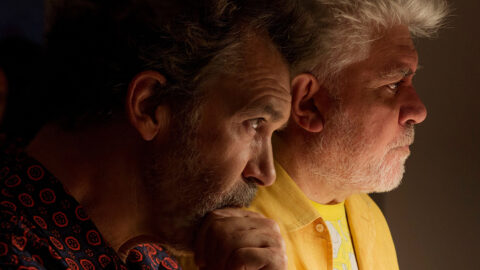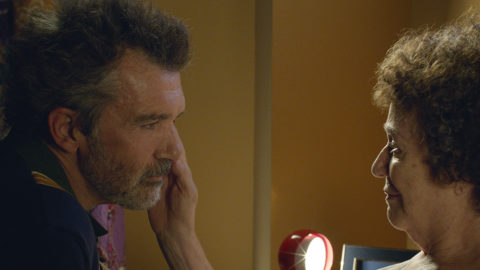Interview: Pedro Almodóvar
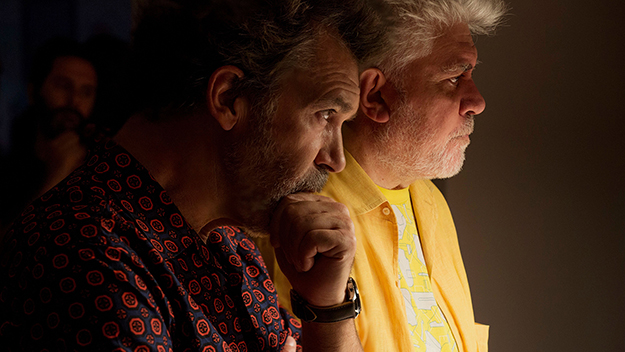
Antonio Banderas and Pedro Almodóvar on the set of Pain and Glory (Pedro Almodóvar, 2019)
In his feature in the September-October 2019 issue of Film Comment, Michael Koresky writes: “Pedro Almodóvar leans into the pain with his new film Pain and Glory, his most autobiographical to date. Structurally, the genre is a no-brainer, perhaps, for a writer-director who has long preferred to tell stories centrifugally, spiraling out from a revelatory center rather than having finite beginnings and endings. Almodóvar’s movies of the 21st century especially, such as Bad Education (2004)—with which this film shares a strong kinship—Broken Embraces (2009), and The Skin I Live In (2011), have consistently moved away from linearity, as though coasting on the waves of memory. In Pain and Glory, Almodóvar makes as explicit as he can that, although it’s a fictional film, much of what we see on screen is based on his own life, right down to the furnishings and paintings on the walls, many of which have been modeled on things he owns, and some of which were lifted from his apartment during shooting. In this latest film, which is a deeply moving inquiry into the catharsis of delving into one’s own past, and the salvation in coming to terms with it, Almodóvar’s drive toward autobiography goes way beyond ‘write what you know.’ This is more like ‘show who you are.’”
Film Comment sat down with the filmmaker last spring to discuss his highly personal new film.
This interview appeared in a condensed and edited form in the May-June 2019 issue of Film Comment.
You usually say that you have a lot of stories already figured out in your mind for your next films, but I’m very curious to know if the starting point for Pain and Glory has anything to do with the shape it took at the end of the process. The structure is almost plotless and it seems to me that, more than any other of your films, it’s been a work in progress the whole time, a real jump into your memories, taking different directions.
Cinema is always unpredictable. When you write, when you shoot, when you edit. During shooting I was so happy working with Julieta Serrano, who plays the old mother, that I decided to add two more scenes that end up being crucial to the story, or to the portrait I’m filming of this man and his relationship to the past. I wrote them the night before we shot them. I haven’t lived that conversation he has with his mother, but I surely can identify with it because it’s been in my mind for so long. Looking back on it, I think it’s such an important scene because it expresses very precisely what it was for me as a kid to feel that special look you get from some people. At school, outside the home, in the village, anywhere—that sensation of people looking at you like something different, there is something offensive in that look. The scene is about that. Maybe the whole movie is about that.
I thought it was going to be a very sad film. But films choose you rather than the other way around. When I feel something special I just jump into the water, but it wasn’t the kind of film the audience wants to watch. The only thing that has proven right for me in the twenty films I’ve made is the certainty that I wanted to do them, and that is what leads me before anything else. I didn’t have a clue about the possible reactions, that’s why I’m surprised by the ones I’m hearing, and that highlight the emotion within the film. I’m very happy with them and they give me comfort.
Both Pénelope Cruz and Julieta Serrano incarnate Salvador’s mother in different time periods. We see an evolution in this woman, as bitterness grows inside her over the years. Is that situation similar to the relationship you had with your own mother?
I wasn’t trying to create a portrait of my mother. I’ve done that before in The Flower of My Secret (1995) with Chus Lampreave, and it’s the nearest I’m going to get to depicting my mother in film. But some scenes and parts of the character do obviously come from her. She never watched my films, she knew she wasn’t going to like them, so we could never talk about my films, but she was very happy with my success. And the moment she gives instructions on how she must be shrouded in her coffin is absolutely real. I always cry at the line when she says that where she is going she wants to travel light and asks her son to take her shoes off, something that is completely against tradition and burial rituals in La Mancha.
Though death and disappearance are all over the film, it is quite enigmatic the way the film unfolds into some sort of enlightenment for Salvador.
Death is all around in the film. But less obvious is the death of sexual desire, which in a sense is what Salvador feels, and explains why he goes back to his childhood and to the birth of that desire. All this comes back with the monologue “The Addiction” that he gives to an actor, and which finally leads Leo, his former lover from the eighties, back to him. I use theater as a messenger, which is one of the reasons theater was born anyway. I love to film my characters entering a cinema or a theater and watching their past or even their future being represented in front of them.
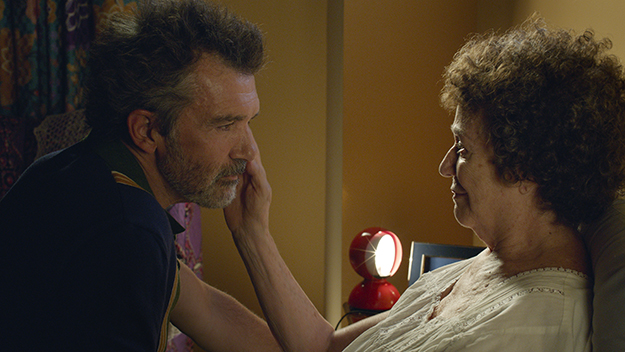
We hear parts of that monologue in the film, but did you actually write out the whole thing?
Yes. It was originally titled Cinema and the Liquids, which is quite odd but makes sense for me, because cinema smelt like urine in my childhood. We pissed behind the screen at the open air cinema in summer. That is where I discovered and fell in love with movies. The white screen in fact becomes an icon in the theater representation in the film. The monologue talks about a normal experience really, the desperation of having to break up with someone you love but who at the same time is destroying you.
There was a moment where this monologue interacts directly with Judy Garland’s in A Star is Born, one of my favorite films. She is dressed as a clown and has a very long talk with the studio’s chief about Norman Maine (James Mason). It is a very dramatic dialogue in which she blames herself. It’s full of wrath and bitterness and impotence, because she can’t help the person she loves the most, and the person is not able to help himself either. This kind of impossible dependence is the one that Salvador and Leo lived. And like Pain and Glory, it is also very connected to the notion of liquids—Maine is an alcoholic and eventually, he dies in the ocean, on Malibu Beach. I had the piece “The Addiction” written and decided to give it to an actress to put it on stage.
Anonymously, like Salvador in the film?
Of course. It was my idea for my theater debut, but as an unknown artist. I didn’t want the audience to pay attention to the fact that this is an Almodóvar play. I also wanted to find out if it really works on stage as emotionally as I thought it could. Finally the monologue is staged in the film, and becomes the center of it. When Salvador says that he wants to go to the Cinematheque just to find out if the film he made 30 years ago is still alive, what he says comes deeply from my notion about my own work.
I never look back to the films I’ve done, but at the Spanish Cinematheque, where you programmed my retrospective two years ago, I was able to introduce and watch a restored print of The Law of Desire (1987) again. It was very moving to feel that the film still talks so much about our times. I think I’ve been very lucky because time is taking care of my cinema quite well. In 30 years, a lot of things change. It is easy to grow old very fast. But that has not happened to some of my work, though it has to my body. Those are my glories and my pain.
You decided not to recreate the ’80s in Madrid, but to invoke them through words, through theater. Why this decision?
There are a lot of reasons for me not to do that. One of it is that I would have been driven to film a very dramatic moment, when Salvador has to abandon Leo, and I didn’t want to show that. That period of time has already been filmed in the movies I made back then. What is really important to me is that the three male characters come from the ’80s, and from La Movida in Madrid. Their senses and their minds were developed in that special period of time, when so many things where exploding and changing the face of our country. They have a special relation with sex and drugs that comes from those years. Even if I don’t recreate those years, I think this is the film in which I talk most extensively about what those years really meant for me and for Spain.

Pedro Almodóvar and Asier Exteandía as Alberto on the set of Pain and Glory
Did you imagine that 30 years later we would be in this political situation, with the rise of the extreme right wing a global phenomenon?
Not even in my worst nightmares. It happened with Trump in the United States, with Bolsonaro in Brazil, with Savini in Italy. It is terrible what is happening, how so many freedoms and social battles we won so long ago are really in danger. It is heartbreaking. And it looks like something similar could happen here in Spain. I have this very dramatic feeling of how the world is evolving without a hint of humanity. It makes me sick, the treatment that immigrants are receiving all over the world, the international conflicts all over the globe, like we haven’t learned anything from the past. I can’t escape that as a human being or as an artist.
There’s a nostalgia in the film that was uncommon in your work until Julieta (2016) and Pain and Glory.
I don’t usually like films or books that make a big deal about nostalgia, but it’s true that this time I couldn’t avoid it. When you watch the film, though it wasn’t my intention, there is clearly a sense of nostalgia and sorrow going on. I think it has something to do with the fact that I don’t like the world in which I’m living right now, and I don’t like my body either. I don’t feel comfortable almost anywhere. I don’t like myself because I’m aging so badly, everything hurts, and I can’t do anything about it.
Pain and Glory is a film about what time, the passing of time, inflicts on our lives. It is a film about how my memory works, so I guess it was impossible to avoid nostalgia. This sense of permanent erosion and degeneration that affects me is also the maelstrom of our times. I look around and everything is falling apart—humanism, commitment to our planet’s future, fact-based truths that are constantly being twisted and ignored. Even cinema itself is disappearing from the big screen, which is crazy and makes me very sad. I’ve always been a positive person, but now I see very few reasons to be. I wish we lived in another era, really, because everywhere you look is dark. I’m 69 years old and I can’t fight against my body. I can’t fight against a world I don’t like either.
Like Salvador, do you fear not being able to shoot more films because of your health?
It is an unbearable feeling. In my case that fear is not as strong as it is for Salvador, but it’s getting there. Will this be my last film? I hope not. And I don’t think so, but I will be seventy soon enough, and the pains I have all over my body are not getting better. Making cinema is a very physical thing, demands that you stay in shape. That image of John Huston shooting The Dead in a wheelchair touches me, but I’m not sure I could be able to do that. It is a fear I live in and which I have to manage. And that was a starting point, no doubt about it, for Pain and Glory.
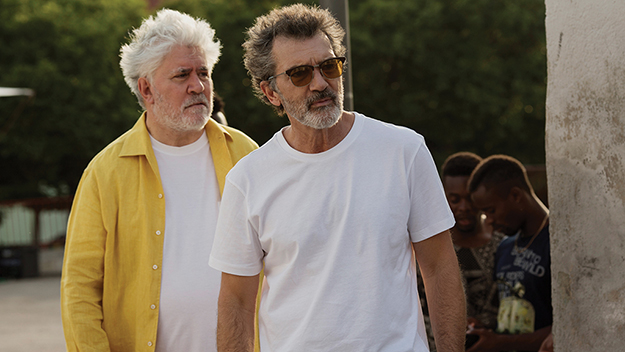
Pedro Almodóvar and Antonio Banderas on the set of Pain and Glory
Your self-portrait is not self indulgent. There is a great deal of generosity in the way you expose yourself and the process of creation.
These things are hard to talk about. I was scared to make this film because I had to explain my clinical background and health status to the viewer, and at the same time, I wanted to run away from self pity and wailing. But I had to tell the viewer about the maladies and pains of my protagonist, so I made a list of them that could be said in 2.5 minutes. It’s not cinematic, but it is an essential information. It should never be an example in film schools because it is exactly what you must avoid in a script—long explanatory sequences–but fortunately, I had the talents of Juan Gatti and Alberto Iglesias on my side, working on the infographics and the music. Their work is so inspired. I was conscious of it being the most audacious sequence of the film.
Maybe on the level of aesthetics, but as far as moral content, the most audacious sequence is the way you film the “first desire” of a 9-year-old boy. How did you approach it?
The main difficulty was to combine the homosexual desire of a 9-year-old boy and a young bricklayer. It is an explosive combination, so the approach for me was to keep it as an innocent act. Which in fact it is. I had the Bad Education experience, where I filmed something similar, but this was more difficult to resolve and also more crucial to the story, because I had to express to the viewer the notion that there is a desire being born for the first time. Both characters are pure and innocent, and the actors didn’t have a clue what I was filming. I didn’t want them to know, and didn’t explain. I’m so happy with their work. They were great discoveries for me, César Vicente and Asier Flores, completely unknown actors who were born for the screen. But, without being filthy or dirty about the desire, I had to make clear that the desire comes from the boy to the bricklayer, and not the other way, which would be pedophilia. This never happened to me in my childhood. I never fell in love with a bricklayer. But I could have, so I can identify with that feeling.
A lot of great filmmakers, in some point of their career, have felt the need to portray themselves. Is that the case with you?
I guess that, consciously or unconsciously, I did have that need. But it was something that built up. There are, of course, a lot of films that work as an autobiography in a sense, but I don’t think that’s the case with Pain and Glory. It is not a simple thing to explain. I think that the film has not as much in common with Fellini’s 81/2 as with Iván Zulueta’s Rapture (Arrebato). The autobiographical element is not something obvious in that film, but it is there. The drug devouring a filmmaker’s mind, the relation he establishes with the drug and his childhood memories. From the outside, we all identify heroin with death but for the protagonist of Rapture—whose name is Pedro by the way—heroin is his first vital choice, like when Richard Dreyfus decides to live the absolutely alien adventure in Spielberg’s film. In my film, heroin opens a door for Salvador to places where he did not want to go—back to his childhood, to his former lover, to his previous films, to his mother who died some years back. It is a classic element. It’s like the elixir in Shakespeare’s A Midsummer Night’s Dream. An altered state of mind takes us to a place you don’t choose. That’s also how creativity works, in a sense.
Did you use drugs for creative inspiration?
It has never worked with me that way. I didn’t use heroin either. I’ve never tried it. I could have, because it was all over the place back then, and a lot of my friends used it—some of them died because of it. But I’ve never used heroin because I knew where it could take you and, on the other hand, I had the intuition that it wasn’t a drug for me. My personality matches better with cocaine.
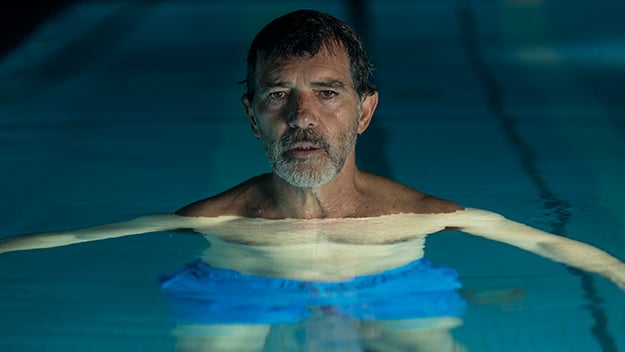
Pain and Glory completes a trilogy of sorts with The Law of Desire and Bad Education, but you have always denied a complete identification with the filmmakers you depict in those films. In Pain and Glory, the autobiographical and artistic connections are impossible to elude.
Yes, I know. I even give my house, my collection of art, my clothes, and my hairstyle to Salvador Mallo. This makes him a sort of alter-ego, but this is not a confessional film. Everything I gave Antonio’s (Banderas) character which came from me came from a straight-forward and pragmatic decision. It sounds vulgar, but at first it was just a creative strategy. I had finished a script which I wasn’t very happy with, so I needed to start something new as fast as possible and I used myself. That way I could skip all the investigation process for the character—I just had to imagine a projection of myself.
Would you deny that the film is autofiction?
I don’t feel it that it is autofiction, though I’m deep inside the film. I’ve walked the same emotional roads that Salvador has. I’ve used myself as a reference, but just to visit parts of my life that I hadn’t before. At least, not in this form. I’m not talking about autofiction, but about a film that starts with me and becomes a very elaborated fiction. The commitment to truth disappears and what really matters is the cinematic truth, not the biographical truth.
How did you work out these ambiguities with Banderas?
Maybe some people would not believe it, but Antonio did not imitate me for a second. I told him he could do it if it helped him, but he refused. What he has done is something incredible. He has fictionalized me within the rules of my own universe as a writer. This is by far, I think, his best performance. He has worked against the kind of male-driven energy he has established as an actor. I really think this is a huge turning point for him. It was a big challenge, and he is absolutely sweeping.
The notion of liquidity is very present in your films, especially since All About My Mother, with the blood and the diapers commercial. In a sense, we associate it with the liquid narratives of your scripts, with complex structures that flow in a very organic way.
You can’t imagine how much effort it requires for me to achieve that. I’m happy you say it, because the transitions between three different time periods are essential for the script in order to find the form and the fluidity I’m looking for. I spent a great deal of time and energy on that, writing, and also editing. One of the catalysts of Pain and Glory is that, when I’m in pain, the only place I feel right is in the water. I spent a lot of time in a swimming pool the summer I wrote the script. That’s the first image of the film, the origin of everything, a man without gravity, under water. The water is like the amniotic fluid that takes him back, deep into his memories. From the swimming pool, I cut to the river of childhood, in probably the most luminous scene of the film. I automatically established the time lapse structure through the water. So this notion of liquidity makes sense to me.
This interview was translated from Spanish by the author.
Carlos Reviriego is deputy director of the Filmoteca Española in Madrid.



